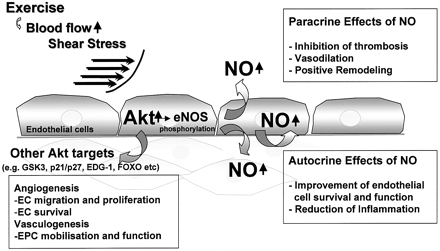
The Benefits of Physical Activity
Hannah Carey
Emily Lawrence
Alexander O'Dell
Many sources extol the health benefits of being physically active, but what are the benefits and how important are they?More and more evidence is being released about the benefits of exercise on individuals, but what is true? The benefits range depending on the health of the person as well as the part of the body being studied. There are many factors affecting the impact of exercise including age, sex, weight, other health conditions, etc. In this module we will look at some of the major diseases impacted by exercise, including:
Exercise and physical activity are broad terms that include many different kinds of activity. Different studies have identified different types of exercise as being more beneficial than others. A study in 1995 from the CDC and the American College of Sports Medicine determined that adults should engage in at least 30 minutes of moderate intensity exercise most days of the week. The major types of exercise are:
Source: Pate, Russell R., Michael Pratt, Steven N. Blair, William L. Haskell, and Caroline A. Macera. "Physical Activity and Public Health: A Recommendation From the Centers for Disease Control and Prevention and the American College of Sports Medicine." JAMA 1995;273(5):402-07.
After successfully completing this module, the student will be able to:
Most of the benefits of exercise affecting cardiovascular disease are actually reducing the risk factors for cardiovascular disease. Some major risk factors include: high LDL cholesterol, uncontrolled high blood pressure, obesity, diabetes, high C-reactive protein, atherosclerosis (Link to atherosclerosis module), etc. It has been shown for a long time however that exercise has healthy benefits on the cardiovascular system.
It has been shown in studies for a long time that exercise correlates with better cardiovascular health. A study back in 1984 looking at Harvard alumni showed that post-college exercise correlates with low coronary heart disease risk. The alumni with sedentary lifestyles had a higher risk, even if they were varsity athletes in college. The overall conclusion to the study was that level of exercise is inversely proportional to total, cardiovascular, and respiratory mortality. This study looked at the benefit of exercise independent from other elements including smoking, obesity, hypertension and heredity.
The Nurses' Health Study is an ongoing study, but a recent publication showed a similar result, but did not look at exercise independently. Instead, this study categorized nurses by several lifestyle factors, one of which was exercise. In the end, they concluded that women who didn't smoke, had a healthy BMI, had a healthy diet, and engaged in vigorous exercise had a 0.17 relative risk for coronary heart disease compared to all other nurses in the study. While it is unclear from this how much of the risk reduction is actually due to exercise, we can conclude that exercise does play some role in reducing risk.
Sources:
More recently, studies have looked at the mechanisms behind the benefits of exercise. Although a lot more information is known about the effects of exercise on the cardiovascular system, there are still a lot of questions to be answered. One study found that exercise relates to the levels of inflammatory markers. The study specifically looked at an older population, but it was still conclusive. They specifically looked at C-reactive protein, interleukin-6, and tumor necrosis factor alpha, all of which are inflammatory markers. Exercise was associated with low levels of all of these after controlling for body fat. A high level of all of these is associated with a high risk of cardiovascular disease, so reducing them is healthy for the heart.
Another primary mechanism is the functional activity of the vascular endothelium. The increase in exercise causes an increase in blood flow, which enhances the vasodilatory capacity of arteries. Specifically, it is nitrogen monoxide (NO) that is responsible for all of the benefits. Endothelium derived NO leads to inhibition of endothelial cell apoptosis, suppression of inflammatory activation, and an increase in the activity of oxygen-radical scavenging enzymes. These are the basic effects, but the full mechanism comes down to gene regulation which can be found in the article. The diagram below provides a summary.

Sources:
This section is kind of messy. Too many bullets and not enought coherent explanation.
Many of the effects of exercise on the cardiovascular system depend on the study population and not all have found that exercise has a significant impact on the cardiovascular system. Below are summaries of studies looking at these various populations.
The Women's Health Study
https://www.jstage.jst.go.jp/article/circj/77/2/77_CJ-13-0007/_pdf
http://www.nejm.org.ezproxy.bu.edu/doi/full/10.1056/NEJMoa042135
Osteoporosis is a deterioration in the structural integrity of bone and loss of bone density due to demineralization that eventually causes fragile bones and an increased risk of fracture.
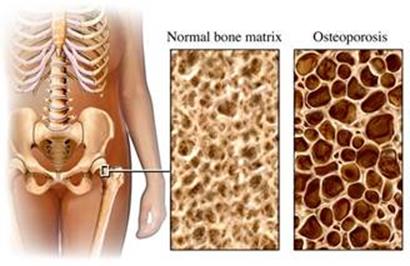
http://www.livtherapy.eu/education/osteoporosis.html
You had several images that more or less showed the same thing. I deleted the two worst images, which owere of poor resolution.
The video below provides a brief summary of osteoporosis. (1.5 min)
Over 10 million Americans have osteoporosis, 80% of whom are women. A drop in estrogen in menopausal women and a drop in testosterone in aging men affects the body's ability to produce bone tissue at a fast enough rate. Post-menopausal women lose bone mineral density at a rate of 1-5% every year. Men's bone mineral density is not significantly affected by age until they are older in years. (www.livtherapy.edu)
This is a public health concern, because it leads to increased morbidity and mortality. Osteoporosis also impairs mobility and one's ability to continue exercising, as well as their ability to work and financially provide for themselves and their families. The financial strain felt by the government is great, and diseases exacerbated by age make a significant impact.
FYI: FYI?
Osteoporosis can also lead to compression fractures of the spine. Often these fractures occur with little to no pain, and may go unnoticed until visible shrinking or stooping of the spine.
Terrible resolultion on this image. Must be a better one.
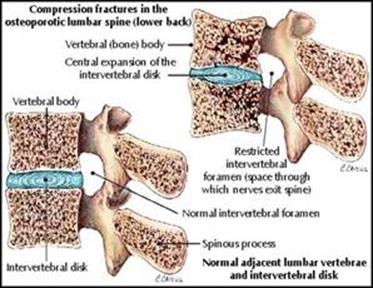
(www.houghton.com)
How about these instead?
|
Source: http://umm.edu/programs/spine/health/guides/thoracic-compression-fractures
|
Source: http://www.joelgarrismd.com/vcf-overview.html
|
This is a confusing jumble. I can't make sense of the jumble of citations and single sentence observations.
Weight-bearing exercise is one of the most effective methods for osteoporosis prevention and treatment. The force of gravity allows simple bodyweight exercises to enact a significant increase in bone mineral density. In addition to the load or weight exerted upon muscles, the frequency of the strain is beneficial to bone mineral density as well. However, swimming does not provide any benefits to bone density because the activity is non-weight bearing.
Lower body weight-bearing exercise, including jumping and lunges, has proven to increase bone mineral density in populations of all ages, from children to postmenopausal women and the elderly. [Taaffe DR, Snow-Harter C, et al.: Differential effects of swimming versus weight-bearing activity on bone mineral status of eumenorrheic athletes. J. Bone Miner. Res. 10: 1995;586-593.]
A cohort of 2,205 middle aged men were enrolled in a longitudinal study for 35 years, in order to measure exercise's impact on risk of fracture. Men with a sedentary lifestyle or men who walked or bicycled only for pleasure had an increased risk of hip fracture compared with men who participated in regular sports activities for at least 3 h/wk. [Michaëlsson, K., Olofsson H, Jensevik K, Larsson S., Mallmin H, Berglund L, et al. Leisure physical activity and the risk of fracture in men. PLoS Medicine 2007;4(6), e199.]
Witzke and Snow performed a cohort study comparing 25 exercisers with 28 controls, all of whom were adolescent girls. The exercisers performed lower body exercises three times per week with weighted vests. The results suggest that plyometric jumping training may increase peak bone mass during adolescence when performed over a longer period of time. [Witzke KA and Snow CM: Effects of plyometric jump training on bone mass in adolescent girls. Medicine and Science in Sports and Exercise 2000;32 (6):1051-1057.]
What are these next two for?
In a 2001 study, Fuchs, Bauer, and Snow carried out a cohort study in which they compared two groups of children who participated in a 7-month exercise intervention during the school day three times per week. The jumping group performed 100 two-footed jumps off 61 cm boxes each session, while the control group performed non-impact stretching exercises. After the 7 months, jumpers had significantly greater changes at the femoral neck and lumbar spine than controls (4.5% and 3.1%). Bone mineral density at the lumbar spine was significantly greater in jumpers than in controls (2.0%) and approached statistical significance at the femoral neck (1.4%; p = 0.085). Their findings show that jumping at ground reaction forces of eight times body weight is a safe, effective, and simple method of improving bone mass at the hip and spine in children. I can't make any sense out of this. Which is jumping and which is control and which is femur and which is lumbar spine?
[Fuchs RK, Bauer JJ, and Snow CM: Jumping improves hip and lumbar spine bone mass in prepubescent children: a randomized controlled trial. J Bone Miner Res. 2001;16:148-156.]
Some authors believe that osteocytes in bone act as mechanosensors, and that they respond to weight bearing stresses by synthesizing and secreting chemical mediators that result in greater bone density. [Hingorjo, M., Syed, S., Qureshi, M. (2008). Role of exercise in osteoporosis prevention - Current concepts. J Pak Med Association 58 (2): 78-81.]
In summary, the benefit of exercise as an osteoporosis intervention result from its ability to:


Major depression is defined as persistent (months long), profound blues or irritable mood, and loss of interest interfering with normal functioning. A person may have one or repeated episodes over a lifetime. Over an individual's lifetime, one may experience depressive symptoms without having a major depressive episode. According to the Center for Disease Control and Prevention, depression affects 1 in 10 American adults.
|
The National Institute of Mental Health describes the signs and symptoms of depression as:
|
There is compelling evidence that physical activity is beneficial in preventing and treating depression.
One of the most powerful components in the development of depression is stress. When the body is stressed, neurons release corticotrophin releasing factor (not corticotropin factor), which stimulates release of adrenocorticotropic hormone from the pituitary gland. This hormone causes the adrenal glands to secrete cortisol. Normally, there is a feedback inhibition by which increased cortisol levels in blood reduces secretion of additional corticotropin releasing factor. One theory is that continual stress can lead to dysfunction of this feedback mechanism, resulting in sustained elevations in cortisol that decreased secretion of brain-derived neurotrophic factor (NBDNF), which causes further damage to hippocampal neurons, thereby contributing to some of the cognitive abnormalities seen with depression.
|
|
|
A review by Farmer et al. [Farmer ME, Locker BZ, et al.: Physical activity and depressive symptoms: The NHANESI epidemiologic follow-up study. Am. J. Epidemiol. 1998;128:340-1351] examined the association between physical activity as it relates to the prevalence and incidence of depression and anxiety disorders. The authors cite several cross- sectional studies that report a high association between regular physical activity and low depression incidence in adolescents and the elderly. Once such study of 5,061 individuals by Steptoe and Butler [Sports participation and emotional wellbeing in adolescents. Lancet 1996;347:1789-1792] suggestted that vigorous physical activity was associated with reduced emotional distress. However, in cross-sectional studies it is not necessarily clear whether reduced emotional stress is a result of activity; an alternative explanation is that those with low stress levels are more inclined to exercise. Therefore, the authors concluded that randomized control trials are needed before concluding that exercise is an effective means of preventing depression.
Depression is historically treated with antidepressants and psychotherapy. The study below showed a significant therapeutic benefit of exercise in individuals with major depression disorder. [Babyak M, Blumenthal JA, et al.: Exercise treatment for major depression:maintenance of therapeutic benefit at 10 months: Psychosom Med. 2000;62(5):633-8.] This randomized control trial was designed to assess the efficacy of physical activity in improving recovery from major depression disorder (MDD). They followed 156 adult individuals over the age of 50 with MDD for 4 months and assessed recovery at 10 months. Three interventions were compared: 1) aerobic exercise, 2) sertraline therapy, or 3) a combination of exercise and sertraline. The study participants were given the Hamilton Rating Scale for Depression (HRSD) in order to determine the severity of MDD at baseline and at follow up of 4, 6 and 10 months. Subjects assigned to the exercise intervention attended three supervised 45 minute exercise classes a week, for 16 weeks. Subjects assigned to the medication group were initially prescribed 50 mg of sertraline and were titrated to a well-tolerated dosage of 200 mg. Subjects assigned to the combination group, received the same dosage of medication and exercise as other two intervention groups.
The analysis of the intervention included 133 subjects, as 23 subjects were lost to follow-up. The results as shown in the graph below show lower HRSD score in subjects who received the exercise only intervention (?? I don't think the graph shows this) (30%) compared to participants receiving just medication (52%) or those received combined therapy (55%) (p = .028). The investigators concluded that moderate exercise of at least 30 min, three times a week can be considered at least as effective as standard pharmacotherapy.
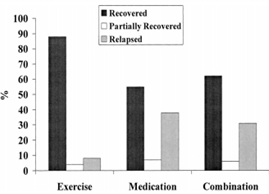
More research is needed in order to determine the best method of delivery and maintenance of physical activity in depressed individuals. In the systematic review Physical activity in the prevention and treatment of anxiety and depression (http://informa healthcare.com.ezproxy.bu.edu/doi/pdf/10.1080/08039480802315640 by EW Martinsen , Martinsen discusses the challenges of setting an appropriate minimum amount of exercise to improve depression. He also highlights the importance of continued research in behavior change models to encourage compliance in physical activity for depressed patients.
Though the exact physiological or biological mechanism remains inconclusive, there are several prevailing hypotheses on exercise's antidepressant effect. There are many regions of the brain that regulate our emotions, yet no single region has be recognized as responsible for depression. In a meta-analysis by Lynette L. Craft and Frank M. Perna on the The Benefits of Exercise for the Clinically Depressed,(http://www.ncbi.nlm.nih.gov/pmc/articles/PMC474733/) the authors outline the following prevailing hypotheses on the biological and physiological relationship between exercise and depression.
Craft and Perna acknowledge that this is the most promising of the prevailing hypotheses. This hypothesis asserts that physical activity increases in the availability of brain neurotransmitters [(insert hidden definition: a chemical substance that is released at the end of a nerve fiber by the arrival of a nerve impulse and, by diffusing across the synapse or junction, causes the transfer of the impulse to another nerve fiber, a muscle fiber, or some other structure).] such as serotonin, dopamine and norepinephrine. A clinically depressed individual exhibits depleted levels of such neurotransmitters. However, studies have only been conducted on animals, and it is still unknown if exercise leads to an increase in neurotransmitters in the human brain.
Photo from slide from class
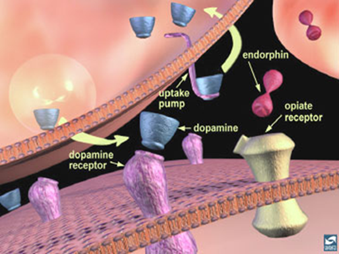
This image demonstrates how dopamine works to enhance or diminish excitability of regions of neurons
This hypothesis asserts that the increase of beta-endorphins ( insert hidden definition: Endorphins are endogenous opioid polypeptide compounds produced by the pituitary gland and the hypothalamus in vertebrates during strenuous exercise, excitement, pain, and they resemble the opiates in their abilities to produce analgesia and a sense of well-being) during exercise have a beneficial effect on depression. Beta-endorphins create an overall sense of well-being and can even induce a feeling of euphoria, often referred to as "runner's-high". Proponents of this hypothesis state that increases in plasma endorphins during exercise contribute to a reduction in depression symptoms. Critics debate if there is enough evidence to link increased levels of plasma endorphins to changes in brain chemistry exhibited in depressed individuals.
Unlike the other hypotheses, the distraction hypothesis is based on psychology and suggests that physical activity provides a distraction from anxieties and depressing thoughts. However critics suggest that although exercise may cause a distraction for depressed individuals, exercise can also "increase positive affect, which is diminished in depressed patients and is not augmented by distraction activities."
In this link Gretchen Reynolds of the NY times blog Well discusses walking as a treatment for depression. Reynolds examines the currents on exercise vs. pharmaceutical medication (SSRI's).
Stephen Ilardi is a clinical psychologist and associate professor at the University of Kansas who has spent his career investigating the cause and treatment of depression. The video below is a 22 minute TEDx Emory in which Dr. Ilardi discusses the "Depression Epidemic" in our civilization and proscribes exercise and omega-3 fatty acids as the cure to depression.
Quiz Question
True or False
Exercise alone can cure major depression disorder
False: Exercise is a supplemental treatment that should be combined with psychotherapy and/or prescribed medication.
Physical activity can reduce someone's risk for developing type II diabetes. Aerobic exercise increases sensitivity to insulin, lowers blood pressure, improves cholesterol and decreases body fat. Physical activity and exercise play a particularly important role in type II diabetes and can even reverse the disease in special cases of extreme lifestyle adjustments.
Type II Diabetes
Type II diabetes is caused by insulin resistance as a result of both genetic disposition and environmental factors such as a sedentary lifestyle and poor diet. In non-diabetics, transport of glucose into cells requires special transport proteins, GLUT-4s. When GLUT-4's are not being used, they are stored in the intracellular membrane. Once activated, they travel to the cell membrane and become functional when insulin combines with insulin receptors or when muscle cells exercise. In type II diabetics, insulin resistance rises with obesity and lack of exercise causing a lack of GLUT-4's (glucose transporters) in the membrane of muscle cells.
Exercise increases the expression of GLUT-4's, which help rid the body of excess glucose by converting it into glycogen. The images below show the difference between facilitated glucose transport in a non-diabetic and facilitated glucose transport in a diabetic.
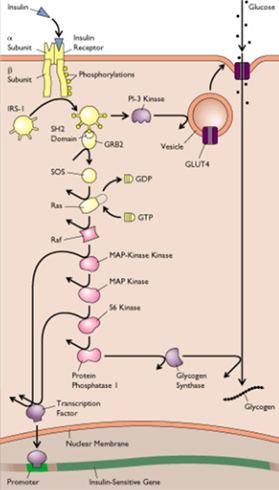
Glucose transport in type II diabetes
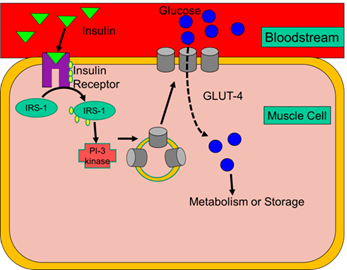
Normal glucose transport
Insert video on exercise and GLUT-4 signaling : http://sph.bu.edu/otlt/lamorte/psa/diabetes
GLUT signaling pathway images are from class slides
In the meta-analysis Role of Physical Activity in Diabetes Management and Prevention by Charlotte Hayes and Dr. Andrea Kiska ( http://www.sciencedirect.com/science/article/pii/S0002822308000175) state that with the growing prevalence of obesity and type 2 diabetes, inactivity is becoming an urgent public health concern. The authors note that after review of 4 trials, three of which were randomized control trials a 31% to 63% decrease in progression of type II diabetes was exhibited in pre-diabetics. Below is an excerpt from their paper summarizing their observations.
"Physical activity is recognized to produce multiple general and diabetes-specific health benefits. Yet despite the multitude of benefits, many people are physically inactive. As the prevalence of overweight and obesity, pre-diabetes, and type 2 diabetes has continued to rise at an alarming rate, physical inactivity has become an urgent public health concern ... In addition to impacting development of type 2 diabetes, regular physical activity participation is associated with numerous health benefits for the individual with diabetes. Physical activity appears to have an independent, beneficial effect on insulin action, glycemic control, and metabolic abnormalities associated with type 2 diabetes."
Put in Red box:
Exercise improves diabetes by:
Rejeski, JW, Ip EH, Bertoni AG, Bray G,Evans G, Gregg EW, Zhang Q, Lifestyle Change and Mobility in Obese Adults with Type 2 Diabetes. New England journal of Medicine 366;13 nejm.org march 29, 2012 (insert hyperlink https://learn.bu.edu/courses/1/13fallsphph709_a1/groups/_25650_1//_1747170_1/Weight%20Loss%20and%20Exercise%20for%20type%202%20diabetes.pdf )
The purpose of this randomized control trial conducted in 2011 was to assess if loss of mobility in type II diabetics was slowed after an intensive lifestyle intervention. The study followed 5,016 obese, type II diabetic individuals (45-75 years of age) for four years. Subjects were randomly assigned to either an intensive lifestyle intervention cohort or a diabetes support-and education program cohort. The intervention group was instructed to make dietary changes and increase physical activity level to 180 minutes a week. Compared to the diabetes support and education cohort the intervention group had a relative reduction in the severity of mobility related disability of 48%. The authors state that "this effect was mediated by both weight loss and improvement in fitness."
The overwhelming evidence of the benefits of physical activity for diabetics is not without its limitations. Behavior change is difficult and starting a regular exercise routine has many barriers. In the longitudinal cohort study Predictors of Sustained Walking among Diabetes Patients in Managed Care: The translating Research into Action for Diabetes (TRIAD) Study (insert hyperlink http://www.ncbi.nlm.nih.gov/pmc/articles/PMC2517953) the authors observed 5,935 patients with diabetes who walked for at least 20 minutes a day at baseline. The investigators found that patients suffering from obesity, pain and comorbidities had difficulty sustaining a walking routine. This is only one example of why it is important for public health research to continue to research interventions that address barriers to maintaining a physically active lifestyle.
Put in red box:
http://www.diabetes.org/food-and-fitness/fitness (Insert Link)
American Diabetes Association
The American Diabetes Association recommends both aerobic and strength exercises to improve the body's use of insulin.
Aerobic Exercise Recommendations:
A goal of 30 minutes of moderate-to-vigorous intensity aerobic exercise for at least 5 days a week is ideal. It is recommended to spread your activity levels throughout the week, try to not go 2 days in row without exercising. Some types of aerobic activities include:
Strength Training Recommendations:
It is recommended doing some type of strength training 2-3 days each week in addition to aerobic activity in order to make your body more sensitive to insulin and help lower blood glucose.
Additional works cited: